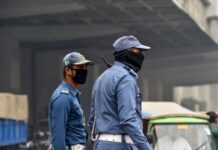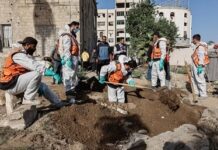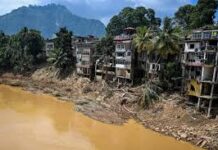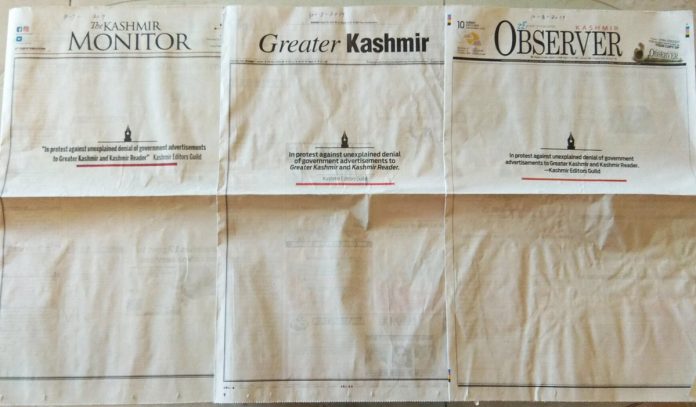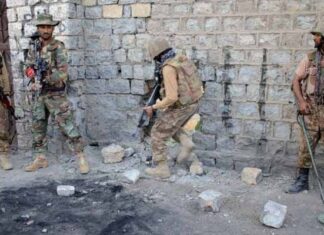- In a long-troubled region of India, articles critical of the national government are being erased from the websites of local news outlets.
- Journalists believe that pressure from New Delhi is to blame
By Aakash Hassan
SRINAGAR: In a long-troubled region of India, articles critical of the national government are being erased from the websites of local news outlets. Journalists believe that pressure from New Delhi is to blame
On a summer day, at his home in Srinagar, journalist Hilal Mir was sitting with his laptop, researching an article. He was looking for a news story that he had written for the local newspaper Kashmir Reader back in 2016, but multiple Google searches failed to turn up the report.
Mir went directly to the paper’s website and typed the headline in its search field. A message saying “No results found” popped up on the page. He then looked for his own author page, but it, too, had disappeared. In 2014, Mir was hired as the editor of the Kashmir Reader and had held the position until 2018, so was puzzled to find four years’ worth of his written work missing from the website.
Growing increasingly curious, he looked for the author pages of former colleagues, but could not find them, either. Then, searching for the bylines of people who continue to work for the paper, he discovered that, while their latest articles were available, nothing dated back further than October 2019. He began to wonder whether it was a glitch in the system, or something more sinister.
It turns out that Mir, 46, is just one of dozens of reporters in Kashmir whose work has disappeared from the websites of local newspapers. Many reporters and editors now tell stories of publications deliberately erasing their work or removing it from public display, following what they believe to be mounting pressure from the Indian government to limit coverage critical of its actions in the territory.
Kashmir is a disputed Himalayan region nestled between India, Pakistan and China. While both India and Pakistan have claimed the territory in full since Partition in 1947, all three countries hold portions of it. The major part, however, is under Indian administration, as the union territories of Jammu & Kashmir and Ladakh. A popular rebellion against New Delhi’s rule has been underway for the past 74 years, during which time India and Pakistan have fought three wars of ownership. Among the long-discussed options for Kashmir’s future, merging with Pakistan and independence are the two most popular choices with people who live there, both of which the Indian government continues to resist vehemently.
For visiting journalists, Kashmir, surrounded by snow-covered mountains and filled with scenic lakes, has long provided a story of loss, pain and dangerously escalating tensions between hawkish nuclear powers. Local reporters like Mir, however, have spent years documenting the struggles of daily life there, from ground zero and with unmatched depth. Their work forms a vital record of wide-ranging human rights violations linked to the Indian armed forces, including rape, torture and the killing and disappearance of hundreds of political activists and civilians — one that many believe the government is attempting to to expunge.
Rising Kashmir is one of the region’s most popular English-language dailies. Established in 2008, its office is located, along with most other Srinagar-based publications, in the crimson-painted government apartments of the city’s press enclave.
According to Riz — a former editor, who asked to be referred to under a pseudonym, citing security concerns — one winter afternoon in 2019, an office manager at the paper demanded login details for its website and social media accounts from technical staff. The next day, the IT manager complained to Riz about the “unprofessional manner” in which the website had been tampered with. Riz was astonished to find that all of his previous articles had disappeared.
That evening, as staff filled the newsroom for the next day’s edition, Riz and a number of his colleagues took up the issue with the paper’s editor-in-chief, Hafiz Ayaz Gani.
“He told us that we were updating from our old website to a new one, which would be more interactive and user-friendly,” Riz recalled. He and his colleagues were relieved to be told that all of the deleted pieces would be back online in a few days.
The website was, indeed, updated. Boasting a fresh masthead design and font, its homepage had a whole new look. But, according to Sub, another Rising Kashmir staffer, “weeks passed, and then months, but the missing data did not get updated.”
“We reached out to technical staff,” Sub said. “The answer was worrying: ‘I can’t do anything. Ask the boss.’”
At least seven former and current employees at Rising Kashmir have confirmed that, upon raising the matter again, they were told by Gani to focus on bringing in “stories of youth and positivity,” not the hard news that “used to happen in the past.”
“Now the newspaper has no data before 2019,” Sub told me.
Gani became the editor-in-chief of Rising Kashmir after his predecessor, the veteran journalist Shujaat Bukhari, was assassinated by gunmen, along with his two bodyguards, outside the office in June 2018. India’s government blamed the killing on the militant group Lashkar-e-Taiba.
Kashmir has long been India’s greatest flashpoint: part of the wider nation, yet separate, and riven with fear and suspicion on both sides. To India’s government — led by Prime Minister Narendra Modi’s Hindu nationalist Bharatiya Janata Party — it is widely viewed as a restive, predominantly Muslim anomaly, at odds with the values and identity of a majority-Hindu nation. Meanwhile, many Kashmiris have for years believed that New Delhi wishes to bring the region to heel by changing its demographic character.
In August 2019, those fears became more real. India’s government imposed harsh restrictions on Jammu and Kashmir, unilaterally revoking the constitutional autonomy held by the region since 1954 and dividing it into two federally controlled territories. In addition to overturning a number of long-standing laws — including one prohibiting the sale of land to non-Kashmiris — hundreds of people were detained. Communication lines, including the internet and mobile networks, were also severed.
The crackdown, which was meant to quell dissent, lasted for 17 months and became the longest-ever internet shutdown in a democratic nation. News organizations were paralyzed until the government set up a media centre in Srinagar, equipped with four computers (later increased to seven) and a working mobile phone. It was the only place for reporters with over a hundred international, national and local newspapers to access the internet.
Along with those of prominent regional publications, such as Greater Kashmir, Rising Kashmir and the Kashmir Reader, the pre-2019 digital archives of many other Urdu and English-language papers also began to be either partially or completely erased. While editors and members of senior management I spoke to cited a variety of different reasons for the disappearance of content, many journalists find the timing suspicious.
During a telephone conversation in September, Ashiq Ahmed, who manages the Kashmir Reader’s website, told me that a large number of articles were lost from the publication’s archive in August 2019, because the organization could not pay its annual website fees without internet access.
Speaking by telephone, Hafiz Ayaz Gani told me that pieces have gone missing from Rising Kashmir’s digital archive because the “website is under construction.” When asked about questions raised by his own reporters, he simply said, “I have no idea.”
To Riz, the deletion of historic articles from newspaper websites is a clear attempt to control narratives inside Kashmir. “The idea is to write-off facts and truth about the situation in Kashmir,” he said.
“The authorities in the region have often made attempts to silence the victims of violence and harassment,” he added. “Anything that challenges that is being erased.”
It also appears to have started before August 2019. In September 2017, India’s National Investigation Agency (NIA) arrested the photojournalist Kamran Yousuf, a regular contributor to local news outlets, including Greater Kashmir.
While Greater Kashmir did carry news of his arrest, it did not say that Yousuf was a journalist, and certainly not one it was associated with. Some of his work, including stories on civilians killed by government forces, also mysteriously disappeared from the publication’s website.
Yousuf was accused of “pelting stones” at Indian security forces. An NIA charge sheet against him also stated that he had “neglected his moral duty of covering the government’s developmental programs, such as skill-building workshops and blood donation drives.” International media watchdogs condemned Yousuf’s arrests and described the charges against him as bizarre. He was released on bail after spending six months in jail and is yet to be tried.
In 2018, journalist Auqib Javeed, who writes for the daily Kashmir Observer and a number of other titles, was summoned by the NIA and asked about his stories — particularly an interview he had done with the separatist leader Asiya Andrabi for Kashmir Ink, a tabloid published by the Greater Kashmir group. Not only did Javeed’s articles disappear, the entire Kashmir Ink website was taken offline.
Then, in July 2019, Fayaz Kaloo, the owner and editor-in-chief of Greater Kashmir, was questioned about articles that had appeared in the newspaper three years earlier, following the 2016 killing by the Indian army of a popular and charismatic rebel commander, named Burhan Wani.
Wani’s death led to an uprising that left over 100 civilians dead and thousands more injured. The world’s attention temporarily shifted towards Kashmir after security forces deployed birdshot against hundreds of protesters. Many, most of them young men, were shot in the face, in what was later described as the world’s first mass blinding.
According to four staffers, it was shortly after the questioning of Kaloo that the publication’s website began to be altered, with large numbers of articles and digital editions of the paper disappearing from view.
“It started showing changes. Most of the tags, which help in searches, and many author pages went missing,” said Yas, an editor speaking under a pseudonym. “A number of articles were no longer available.”
One senior journalist, who asked not to be named, said that Kaloo had described being threatened with legal action by NIA agents and told that Greater Kashmir’s past reporting would be used against him.
Kaloo did not respond to repeated requests for comment for this article.
Speaking to me in Srinagar in September, a senior official at the Department of Information & Public Relations said that the attention paid to Kashmiri news organizations sharply increased after the 2016 protests.
“The department always does the monitoring of newspaper content, but we were told to do it more rigorously,” they said. “Anything written against the government would be recorded and sent to the higher authorities on a daily basis.”
Some editors of publications from which online articles have disappeared insist that they played no part in deleting the content themselves. Instead, they say, their publications have fallen victim to hackers.
“Our website was hacked multiple times in past years and, because of that, we would lose some of our previous data,” said Sajad Haider, editor of the Kashmir Observer.
Haider went on to say that the attacks tend to take place when tensions rise in Kashmir and that he believes that “those in power” are behind them.
“When there was an uprising in 2016, our website got hacked and when our technical team finally managed to recover it, after a few days, some of our recent coverage, critical of the government, was missing,” he said.
Anuradha Bhasin, editor of Kashmir Times — one of the region’s oldest English-language newspapers — says that archive material now inaccessible on the paper’s website, including coverage of the 2016 uprising, vanished as a result of “technical issues.” Still, she does acknowledge the deletion of articles “from almost all newspapers in Kashmir.”
“These archives are records of history,” Bhasin told me. “It is very frightening to see this kind of erasure.”
Jammu and Kashmir Coalition of Civil Society (JKCCS) agrees. For the past two decades, the organization has relied heavily on the work of Kashmiri news outlets to document human rights violations in the region. In its 2018 annual report, more than 65% of citations came from the local media. Only a handful of those links work today.
“The issue of the missing newspaper archives is not only making our job difficult,” said a representative of JKCCS, sitting in a rundown office in the heart of Srinagar, it is also hindering “researchers and rights organizations who would rely on our work.”
The organization sees a clear connection between Kashmir’s hundreds of missing people and the deletion of newspaper archives. “Enforced disappearances happen to erase evidence of crimes. Similarly, the newspaper reports are being disappeared to erase the memory of a particular time,” the representative added.
Since its founding in 2000, JKCCS has maintained an extensive hard-copy archive of journalism from the region. However, much of it is now gone. In October 2020, the organization’s office and the homes of some of its members were raided by the NIA, on the pretext that the group was using charitable funds raised in India and abroad to carry out “secessionist and separatist activities.”
Unable to find years worth of his written work online, Hilal Mir had consoled himself with the fact that he had managed to keep some of the articles stored on his laptop. In September, though, the police raided his home and those of three other journalists. Computers and mobile phones belonging to Mir and his family members were seized, along with books and paper copies of his published work.
Now, that small record of his two-decade career has vanished too.
“I feel as if I wasn’t there, haven’t lived and didn’t work for all those years,” he said.
The article was originally published in Coda.





